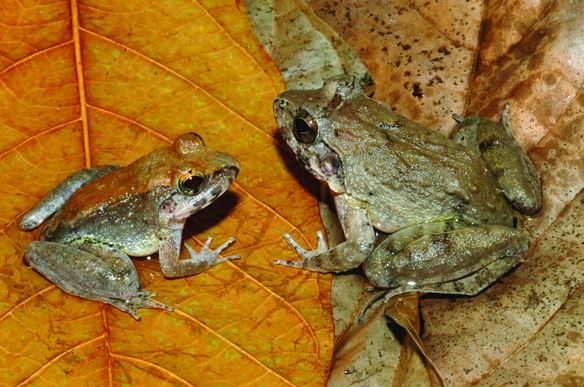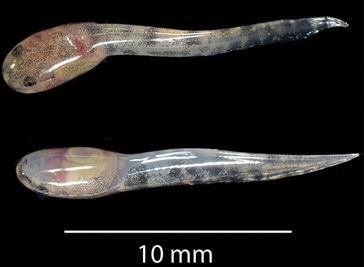There are more than 6,000 species of frogs in the world, but there is only one that we know of that gives birth to live tadpoles rather than lay eggs, and the phenomenon was discovered by a team of scientists quite by accident.
Herpetologist (reptile and amphibian specialist) Dr. Jim McGuire, from the University of California, Berkeley, was wading through the rain forests of Sulawesi Island in Indonesia one night in the summer of 2014 when he picked up what he thought was a male frog.
However, he found himself holding not only a frog but dozens of newborn tadpoles. He had found what he had long been seeking, a female of a species of frog that gives birth to live tadpoles rather than laying eggs.
The species, a type of fanged frog, had been discovered several years ago by McGuire’s colleague Djoko Iskandar, who had suspected it gave birth to tadpoles. However, nobody had ever observed how it mated and gave birth.
L. larvaepartus (male, left, and female) from the island of Sulawesi in Indonesia. The only frog we know of that gives direct birth to tadpoles. (Photo: PLOS ONE)
McGuire said:
“Almost all frogs in the world – more than 6,000 species – have external fertilization, where the male grips the female in amplexus and releases sperm as the eggs are released by the female. But there are lots of weird modifications to this standard mode of mating. This new frog is one of only 10 or 12 species that has evolved internal fertilization, and of those, it is the only one that gives birth to tadpoles as opposed to froglets or laying fertilized eggs.”
Iskander, McGuire and Ben Evans of McMaster University named the species Limnonectes larvaepartus and wrote about it in this week’s issue of PLOS ONE.
Internal versus external fertilization
McGuire explained that frogs have evolved several reproductive methods. Most male frogs fertilize the eggs after they have been laid by the female.
California’s tailed frogs, along with about a dozen other species, have evolved ways of fertilizing eggs inside the female’s body. However, nobody really knows what the mechanisms of internal fertilization are in all but California’s two specimens of tailed frogs.
L. larvaepartus tadpoles. (Photo: PLOS ONE)
While tailed frogs lay their fertilized eggs under rocks in streams, the other species known to fertilize internally give birth to froglets, i.e. miniature replicas of their parents.
Some species have unusual ways of reproducing. A number carry eggs in pouches on their backs, brood tadpoles in their mouth or vocal sac, while others transport their tadpoles in pits on their back.
Two extinct species would swallow their fertilized eggs and brood them in their stomach, with the froglets coming out of their mouths.
Fanged frogs, which have two fang-like projections sticking out of their lower jaw, have evolved into up to 25 different species on Sulawesi. However, only L. larvaepartus and three others have been formally described. They range in size from 2-3 grams to 900 grams. L. larvaepartus weighs between 5 to 6 grams.
The new species appears to prefer to give birth to live tadpoles in non-flowing water, such as pools or seeps located away from pools, maybe to protect them from the larger fanged frogs that hang out around the stream. The research team believe the males may also guard the tadpoles.
Dr. McGuire is a herpetologist – somebody who specializes in amphibians and reptiles. (Photo: University of California, Berkeley)
McGuire first came across L. larvaepartus in 1998, the year he started studying the incredible diversity of amphibians and reptiles on Sulawesi. The island, formed from the merger of several islands millions of years ago, is a geographical hodgepodge.
McGuire said “Sulawesi is an incredible place from the standpoint of species diversity endemic to the island as well as in situ diversification.” He explained that most places in the island are home to five or more species of fanged frogs.
McGuire added:
“We are really interested in understanding how much of Sulawesi’s in situ diversification was initiated on the paleo-islands, or if much or even all of the diversification was post-merger.”
The research is being funded by the National Science Foundation.
Citation:
“A Novel Reproductive Mode in Frogs: A New Species of Fanged Frog with Internal Fertilization and Birth of Tadpoles,” Djoko T. Iskandar, Ben J. Evan and Jimmy A. McGuire. PLOS ONE. Published: December 31, 2014. DOI:10.1371/journal.pone.0115884.



